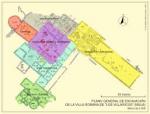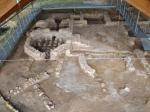Summary (English)
The area known as “Arreaque” or “Los Villaricos” is located on the left bank of the Mula River, 300 metres above sea level. The site extends along a soft slope disrupted to the southwest by a steep cut caused by the river. At present it is crossed by the road that goes to La Cierva reservoir. Thus were delimited two large areas: one north that appears to be the main centre (aim until now of excavation campaigns) and other south, where have been found remains of a new building, many shards, tegulae, etc.
The large area covered by these remains lsugggested from the start the possibility of a wide fundus growing in both time and space, around a central core and other buildings more or less dispersed likely attached to the pars rustica . The architectonic complex structurally consists in 43 different rooms.
Although systematic archaeological survey has not yet been carried out a in the surroundings of the site, there are abundant data on the existence of settlements in the zone. This occupation, which in many cases is continuously confirmed from the prehistoric times to the Medieval Ages, is closely linked to the Mula and Pliego rivers.
According to the excavations, the chronological sequence of the site allows us to establish four occupational phases:
- Phase I: we couldn’t document stratigraphically the initial stage but the ceramics found in the UUEE 2033 and 2035, clogging the compartments A and B, on which are based the structures of the next phase, provide a date around the second half of the 1st century AD. There is nothing new in that because, at that time, a massive growth in the installation and development of many agricultural settlements in this region has been observed. – Phase II: after the destruction of the structures from the first period, the villa was rebuilt in what would be its definitive plan. The thermal zone has a caldarium, its related pool and laconicum. The residential zone consists of yards, corridors and five rooms of different sizes. Among them stand out the thermal complex presenting some complex plans (an octagonal apse that was added later) revealing the great importance given to baths in rural villas since the 2nd century AD.
The beginning of this phase is around the second half of the 2nd century AD and the beginning of the 3rd century, the period of the most productive activity in the settlement. At this time an industrial area in the northwest developed: a torcularium with rooms dedicated to the collection, processing and storage of oil. There are pipes, sedimentation tanks and a large space used for the production and storage of olive oil.
- Phase III: from this stage come the modifications observed in rooms 2 and 5, which seems to follow changes in the production and storage system, probably related to a time with less activity in the life of the settlement. The chronology of these changes has yet to be established, even though the materials (UUEE 2012 in room 2, 2055-2056 in room 5 and 2022-2024 in room 3) corresponding to the dismantling of the third phase mark a facies from the end of the 4th century to the first half of the 5th century AD, representing an ante quem indication for the reforms.
- Phase IV: when most of the the settlement was abandoned, following a period of destruction and fill, some of the area ( the central courtyard, corridor and surrounding rooms) were used and renovated by a residual population for the installation of a cemetery. Different types of burials have been found revealing the use and reutilisation of the site for a long time. The beginning of this period would possibly be in an imprecise time subsequent to the second half of the 5th century AD.
In addition to these four clearly differentiated phases at the thermae zone we have been able to assign some changes to an interval period between the Phases II and III.
(translation by Pilar Alarcón Blázquez)
- Rafael González Fernández
Director
- Rafael González Fernández, Universidad de Murcia, Centro de Estudios del Próximo Oriente y la Antigüedad Tardía (CEPOAT)
Team
- José Antonio Zapata Parra
- Rafael González Fernández (Univeridad de Murcia)
Research Body
- Universidad de Murcia, Centro de Estudios del Próximo Oriente y la Antigüedad Tardía (CEPOAT)
Funding Body
- Ayuntamiento de Mula
- Fundación Caja Murcia






![Download [PDF]](/excavation/skins/fasti/images/results/download_sml.png)

